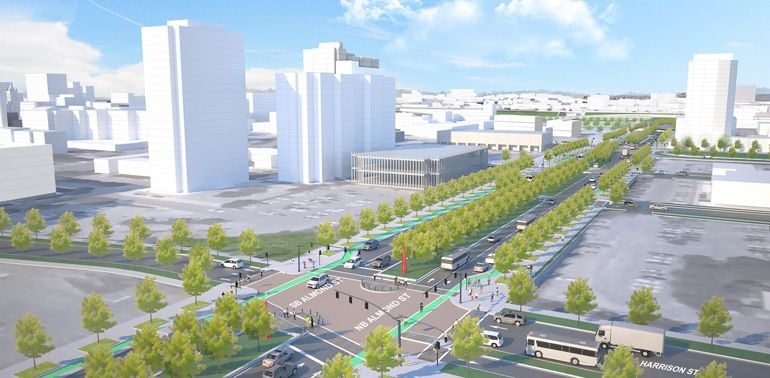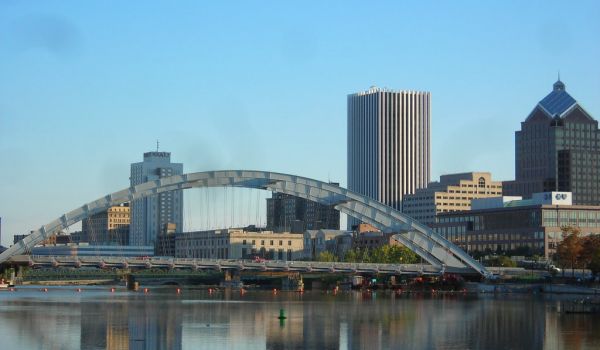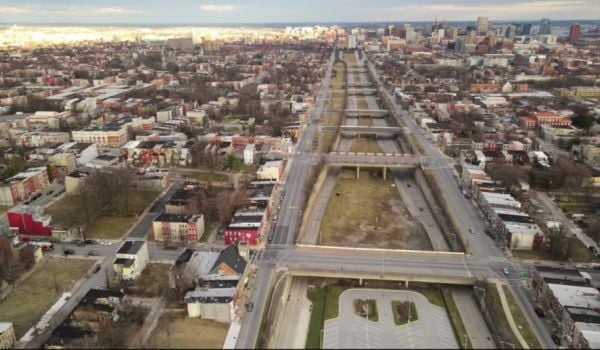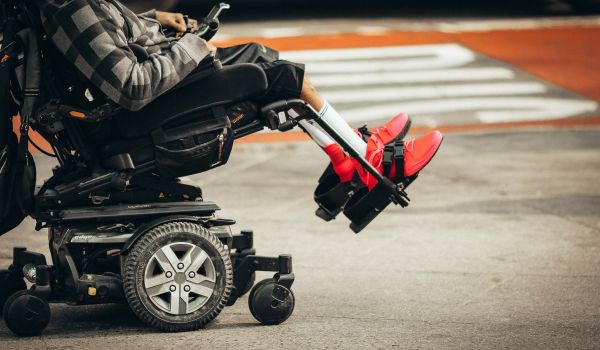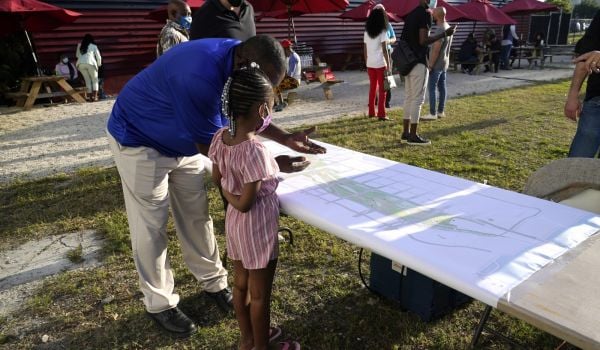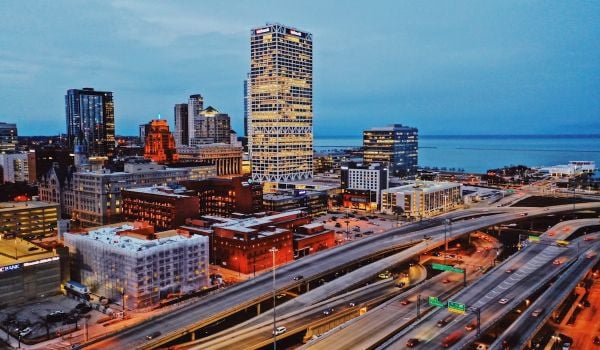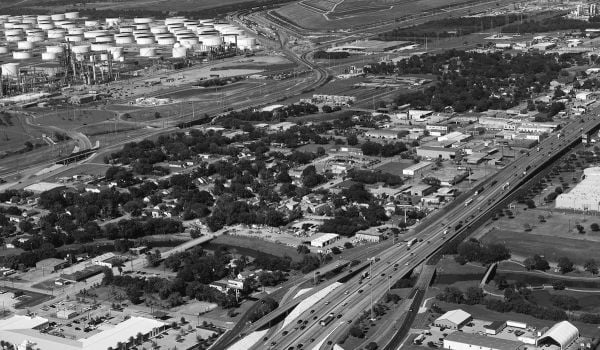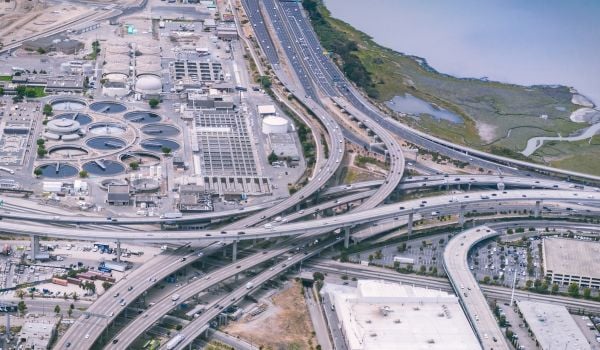New York State Department of Transportation plans to replace the viaduct that runs Interstate 81 through Syracuse. The viaduct, which was built in the late 1950s, cuts through the center of the city and Syracuse’s 15th ward, a historically African American neighborhood.
The proposed plan, which has garnered support from Governor Andrew Cuomo, would replace the 1.4-mile stretch of highway with walkable streets, called a community grid. Estimated to cost anywhere between $1.9 and $2.2 billion, the grid would be a designated “business loop,” connecting commuters from the Interstate to downtown business districts. It’ll reclaim 25 acres of land in Syracuse, turning what is now mostly parking lots into a walkable urban space.
The plan has been welcomed by the Department of Transportation, which chose the grid among other options to replace the viaduct, including a $4.9 billion tunnel. Community organizations, such as the New York Civil Liberties Union, are hesitant, however, to accept a plan that could disrupt the community.
“The replacement of I-81 presents an opportunity to right the wrongs of the past. As far as we can tell, however, the various agencies involved have so far failed to collaborate with each other to ensure they are acting in the best interests of Syracuse residents,” wrote the NYCLU in a February letter to Governor Cuomo and then-Department of Transportation Paul Commissioner Karas.
Prior to the construction of I-81, 90 percent of the residents living in the 15th ward were black. According to Lanessa Chaplin, member of the New York Civil Liberties Union and I-81 project counsel, explains that though the 15th ward was home to working- and middle-class black families, the redlined neighborhood, because of its concentration of black residents, was considered “blighted”. Many redlined communities become sites for “urban renewal” projects, further isolating or disseminating minority communities from cities.
The 15th ward — a safe stop for black travellers and a close-knit community for its residents— rallied to stop the construction of the viaduct. Organizations like the NAACP and the NYCLU adamantly fought the construction. But despite the protests, the highway was built. The ward was ruined, displacing more than 1,300 families, family businesses and destroying 75 percent of the homes of black Syracuse residents.
Now, the proposed community grid has faced backlash from many angles. Destiny USA, the sixth largest mall in the country has hired lobbyists to fight the reconstruction because the community grid would redirect traffic away from the mall — which is located just off the highway. Destiny USA is hoping the federal government will intervene in the state’s plans to stop the construction.
Community organizations and residents are also critical of the plan.
The NYCLU, which was originally founded to protest the construction of the viaduct, has not taken a position supporting the community grid, because, says Chaplin, “there is no way to ensure that the construction will be done in an equitable way where benefits and detriments are evenly distributed.” The organization, however, is working with locals to ensure that whatever is built is built equitably.
Because the project is still in its early stages of development, the NYCLU is still working out what “equitable construction” might mean and how to achieve it. But this could include securing construction jobs for city-dwellers and limiting the negative environmental impacts on at-risk communities.
For example, homeowners and elderly residents are concerned that the construction process, which is estimated to take 4-7 years, will affect their health. Dr. Lemir Teron, an assistant professor at SUNY College of Environmental Science and Forestry who is consulting for the NYCLU, cites a variety of health concerns such as respiratory disease, asthma and gas pollution, that come along with construction.
Teron says that though the community grid will aim to have better sustainability and development goals than the original construction of the viaduct, “these [do not] intrinsically give [residents] racial or environmental justice.” He has many questions for the proposed grid. “Will there be opportunity for African Americans? Are [they] going to remediate legacy pollution?”
“There has to be a concerted effort,” he says.
The state Department of Transportation has been hosting public meetings to talk about the grid. Community members are advocating for construction jobs to be given to Syracuse residents, especially minorities within the community.
The Urban Jobs Task Force and the Legal Services of Central New York published a report investigating the racial disparities in construction jobs. The report finds that the construction trade is overwhelmingly white in Syracuse, so ensuring that construction jobs go to Syracuse’s minority population would be difficult if not impossible given the current racial makeup of its workforce. In its ‘Call to Action’, the report insists on creating a diverse workforce now so that Syracuse residents “will have equal opportunities to work on the I-81 Viaduct Project and other good paying construction jobs in the Syracuse area.”
According to Chaplin, the Department of Transportation will hold a public hearing, which will open a 45 day comment period, where the DOT is required to throughourgly consider community opinions. After the comment period, the DOT will release an environmental impact statement that includes a final plan for the grid. Construction is expected to begin in late 2020 or the beginning of 2021.

Natalia Rommen is the 2019 Next City urban affairs journalism fellow. She is pursuing a degree in Political Science and Communications at the University of Pennsylvania. Previously, she sat on the board of Penn’s African American culture club where she managed the club’s marketing and event planning. In 2019, Rommen was selected as a data analytics fellow for Penn Program on Opinion Research and Election Studies. Rommen uses her experience with statistics to research urban development and policies that affect minorities.
.(JavaScript must be enabled to view this email address)

